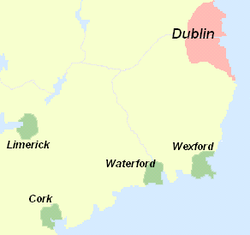利用者:Irish98/ノース系アイルランド人
ノース系アイルランド人 (アイルランド語: Gall-Ghaedheil or Gall-Ghaeil, スコットランド・ゲール語: Gall-Ghàidheil) [1]はマン島とスコットランド西部、アイルランド島東部を含む アイリッシュ海 地域にいた民族である。他の名称としては Scoto-Norseや Hiberno-Norse、 Irish–Norse、 Foreign Gaelsなど。
歴史
[編集]ノース系アイルランド人は元々 バイキング である。彼らは避難場所として、または交易拠点としてアイルランドや スコットランドに植民地を建設した。これが、ノース系アイルランド人の起源とされている。
9世紀頃には多くの入植者(カンブリアに住み着いたノルウェー人を除く)は現地のゲール人と結婚し、ゲール語を用いるようになった。そして、僅かな伝統的礼拝を除き、キリスト教を受容した。
彼らは12世紀のノーマン時代まで、これらの地域を支配し続けた。
ヘブリシーズはInne Gall(外国人の島の意)を語源としている。そして、同時にスコットランド・ゲール語がよく話されている最後の地域の一つとして知られている。
アイルランド
[編集]
The Norse are first recorded in Ireland in 795 when they sacked Lambay Island. Sporadic raids then continued until 832, after which they began to build fortified settlements throughout the country. Norse raids continued throughout the tenth century, but resistance to them increased. The Norse established independent kingdoms in Dublin, Waterford, Wexford, Cork and Limerick. These kingdoms did not survive the subsequent Norman invasions, but the towns continued to grow and prosper.
The term Ostmen was used between the 12th and 14th centuries by the English in Ireland to refer to Norse-Gaelic people living in Ireland. Meaning literally "the men from the east" (i.e. Scandinavia), the term came from the Old Norse word austr or "east". The Ostmen were regarded as a separate group from the English and Irish and were accorded privileges and rights to which the Irish were not entitled. They lived in distinct localities; in Dublin they lived outside the city walls on the north bank of the River Liffey in Ostmentown, a name which survives to this day in corrupted form as Oxmantown. It was once thought that their settlement had been established by Norse–Gaels who had been forced out of Dublin by the English but this is now known not to be the case. Other groups of Ostmen lived in Limerick and Waterford. Many were merchants or lived a partly rural lifestyle, pursuing fishing, craft-working and cattle raising. Their roles in Ireland's economy made them valuable subjects and the English Crown granted them special legal protections. These eventually fell out of use as the Ostmen assimilated into the English settler community through the 13th and 14th centuries.[2]
スコットランド
[編集]現代の姓名
[編集]今日でも、これらの地域では彼らの祖国を起源とする姓名が数多く残されている。
姓
[編集]| ゲール語 | イングランド風の姓 | "Son of-" |
|---|---|---|
| MacAsgaill | MacAskill, McCaskill | Áskell |
| MacAmhlaibh | MacAulay, MacAuliffe Cowley | Óláf |
| MacCorcadail | McCorquodale, Clan McCorquodale, Corkill, McCorkindale | Þorketill |
| MacCoitir | Cotter, MacCotter Cottier | Óttar |
| MacÌomhair | MacIver, Clan MacIver, MacIvor, McKeever | Ívar (Ingvar) |
| MacShitrig[3] | MacKitrick, McKittrick | Sigtrygg |
| MacLeòid | MacLeod | Ljótr (lit. "the ugly one")[4] |
名
[編集]| ゲール語 | イングランド風の名 | Norse equivalent |
|---|---|---|
| Amhlaibh (confused with the Gaelic name Amhlaidh/Amhalghaidh) | Aulay (Olaf) | Ólaf |
| Goraidh | Gorrie (Godfrey, Godfred), Orree (Isle of Man) | Godfrið |
| Ìomhar | Ivor | Ívar (Ingvar) |
| Raghnall | Ranald (Ronald, Randall) | Rögnvald |
| Somhairle | Sorley (or Samuel) | Sumarliði (Somerled) |
| Tormod | Norman | Þormóð |
| Torcuil | Torquil | Torkill, Þorketill |
脚注
[編集]- ^ Clare Downham. Hiberno-Norwegians and Anglo-Danes:anachronistic ethnicities and Viking-Age England. University of Aberdeen.
- ^ Valante, Mary (2008). Snyder, Christopher A.. ed. Early People of Britain and Ireland: An Encyclopedia, Volume II. Greenwood Publishing Group. pp. 430–1. ISBN 978-1-84645-029-7
- ^ McKittrick Name Meaning and History Retrieved on 23 April 2008
- ^ Mcleod Name Meaning and History Retrieved on 23 April 2008
参考文献
[編集]- Downham, Clare (2009). “Hiberno-Norwegians and Anglo-Danes”. Mediaeval Scandinavia 19. University of Aberdeen. ISSN 0076-5864
- Haywood, John (1995). The Penguin Historical Atlas of the Vikings. London: Penguin. ISBN 0-14-051328-0
- McDonald, R. Andrew (1997). The Kingdom of the Isles: Scotland's Western Seaboard, c.1100-c.1336. East Linton: Tuckwell Press. ISBN 1-898410-85-2
- Ó Cróinín, Dáibhí (1995). Early Medieval Ireland, 400–1200. London: Longman. ISBN 0-582-01566-9
- Oram, Richard (2000). The Lordship of Galloway. Edinburgh: John Donald. ISBN 0-85976-541-5
- Scholes, Ron (2000). Yorkshire Dales. Derbyshire: Landmark. ISBN 1-901522-41-5


